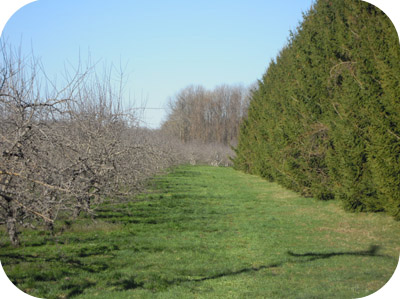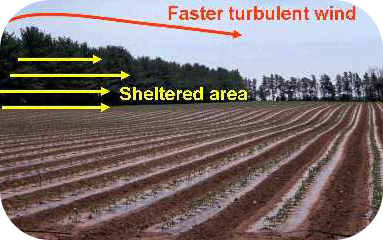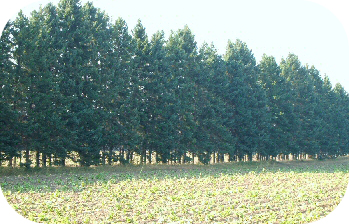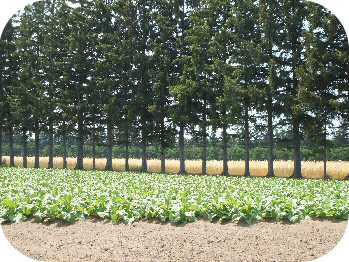Using Windbreaks in new orchards
Fruit trees and developing fruit can be protected from wind breakage and sandblasting by the proper design and placement of windbreaks. In apple orchards, we provide tree support with trellis or tree stakes to encourage trees to produce more fruit and less structural wood - using windbreaks can help accomplish the same thing by reducing winds movement of trees and limbs.
Windbreaks have many potential benefits for orchards including:
- Reducing wind damage like leader breaking, graft union twisting, limb rubs on fruit, leaf tears, and desiccation
- Reducing sandblasting injury during wind erosion events
- Reducing winter desiccation on exposed sites
- Holding snow cover in place to reduce cold penetration deep into the soil
- Reducing salt injury along highways (Colorado spruce and Austrian pine are more tolerant to road salt)
- Reducing spread of bacterial disease during wind storms eg, fire blight, blister spot
- Improving spray coverage by reducing wind disturbance of spray patterns
- Reducing off-site spray drift
- Reducing stress on trellis or tree stakes, especially at full crop load
- Blocking public viewing of spray applications
- Providing refuge for beneficial species
- Reducing wind and water erosion, especially on vulnerable sites with steep slopes and/or sandy soils.
- Improving labour efficiency by improving worker comfort in all seasons
Windbreaks can cause some problems if not properly designed or situated. Here are some considerations:
- Avoid creating a frost pocket, especially at the lower edge of a slope. Windbreaks need to be porous enough to allow some air movement through them. If needed, removal of lower branches can enhance wind flow out of a frost pocket.
- Avoid species that carry pest insects or diseases. For example Eastern red cedar (Juniperus virginiana L.), is the alternate host of Cedar-apple rust and should not be used near apples. White pine can host white pine blister rust which is a devastating disease on currants.
- Avoid weed problems by leaving enough space for mowing close or herbicide banding under windbreaks.
- Avoid host species of problem insects like hawthorn, wild cherry, roses, etc. Roots of walnut can kill apple trees with the natural toxin juglone.
- Avoid putting windbreaks in areas that may attract nesting birds which may feed on the crop.
If your site has existing windbreaks or shelter belts, you should evaluate whether they are still achieving the protection you want. Are they overgrown with too many holes where trees died out? Do they need renovation or rejuvenation with new tree rows?
Here are some tips for planting new windbreaks:
- Timing: Prepare the site a year in advance by controlling weeds, and preparing a good seedbed for planting. Just like orchards, spring planting should be done early, or fall planting can work as well when soil conditions are good.
- Species: More than one species should be used to provide diversity, and avoid unforeseen problems with suitability to your site. Eastern white cedar is a traditional windbreak tree, but is very thick. Cedar is best alternated with other conifers, such as Norway spruce and white spruce. Spruce is very effective, not as dense as white cedar and does not create turbulence downwind of the tree row. In drier soils, red pine, white pine, Austrian pine and Colorado spruce are tolerant and can be mixed with eastern white cedar. For deciduous trees, grey alder will fix nitrogen from the atmosphere, adding to soil fertility for other species. Hybrid poplar is fast growing but is short lived with competitive roots. Basswood can tolerate wet soil conditions, and its late spring flowers provide a useful refuge for pollinating insects such as honey bees and wild pollinators. Black locust is also a 'bee-friendly' tree for pollinating insects; however, it contains natural toxins and should not be used near food crops or livestock in windbreaks. Native honey locust is a safe nitrogen-fixing tree species and does not contain toxins.
- Design: At least 2 rows of trees are recommended, with 3 rows preferred. This allows the windbreak to close in quickly to provide protection. Each windbreak will be different because the nature of the windbreak should reflect the job for which it is intended. For example, a windbreak to stop snow drift is not the same as one that effectively filters pesticide drift.
- Weeds: Controlling weeds under the trees will promote faster growth, and prevent new problem weeds from establishing in your orchard. Herbicides registered for use on windbreaks are listed in Pub. 75, Guide to Weed Control. Plan to scout for weed escapes in early June and spot treat where needed. Perennial weeds like to establish in windbreaks, so early spot treatments can prevent later headaches.
- Water: Just like fruit trees, windbreak trees need to be well-watered at planting and through their establishment years. Use of mulches or landscape fabric has worked well to preserve moisture. Many failures to establish windbreaks are related to lack of water.
- Pests: Most windbreak species have few pests, but it is important to check for any disease or insects that may prevent the windbreak from doing its job.
Advice and assistance with windbreaks is available at most Conservation Authorities.
Read more about windbreaks on the OMAFRA website.









